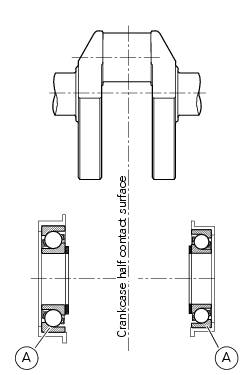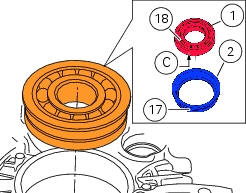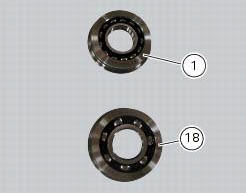
Ducati Diavel Service Manual: Main bearings
The main bearings have are of the angular contact type with offset inner races so that the balls transmit loads from one groove to the other along straight lines at an angle to the axis of the bearing. The angle-contact ball bearings are designed for bearing combined loading (radial-axial loads).
Bearings of this type can bear thrust loads in one direction only. In fact, under the action of a radial load inside the bearing, an axial force is created that must be counterbalanced by an axial force acting in the opposite direction; that is Why these bearings are generally fitted back to back in pairs.
Note
The main bearings supplied can be bearings with bushing (a) or flanged bearings (b) with the bushing integrated in the external ring of the bearing.
To renew the bearings proceed as follows:
- Heat the crankcase in an oven to 100 C;
- Remove the bearing using a drift and hammer;
- Install the new bearing (while the crankcase is still hot) keeping it perfectly square in its seat using a tubular drift that only bears on the outer ring of the bearing;
- Allow the parts to cool and check that the bearing is securely seated in the crankcase half.


Bearings with bushing
Important
On worn engines, the bearing holder may no longer be a tight fit in the crankcase half.
After having removed the bushing, check that the interference fit between the crankcase and the bushing, with bearing fitted, is no less than 0.03 Mm, otherwise, replace the crankcase halves.
Note
Fit the bearings (1) and (18) orienting them so that the side with the "letter" (c) is facing the bushings (2) and (17).

Flanged bearings
Important
On badly worn engines, bearing outer rings may have developed clearance in the crankcase halves - normally, bearing outer rings are interference-fit in the casing.
Check that the interference fit between the crankcase and the bearings (1) and (18) installed, is not less than 0.03 Mm, otherwise, replace the crankcase halves.

Important
After installing new main bearings, shim the crankshaft as described in the paragraph "shimming the shafts" and "reassembly of the crankcase halves" of this section.
 Overhaul of the crankcase halves
Overhaul of the crankcase halves
Carefully examine the engine crankcase halves.
Check that the surfaces of the crankcase halves are perfectly flat using a
reference surface.
Check that the bearings (1) and (18), and the bushing ...
 Reassembly of the crankcase halves
Reassembly of the crankcase halves
The crankcase halves must be in good condition and perfectly clean. The
mating surfaces must be perfectly flat and free
from burrs.
Overhauling the alternator-side crankcase half
The following pa ...
Other materials:
Engine on/off
Warning
Before starting the engine, become familiar with the
controls you will need to use when riding (page 99).
Warning
Never start or run the engine indoors. Exhaust gases
are toxic and may lead to loss of consciousness or even
death within a short time.
In the presence of the active or ...
Gearchange mechanism
Gearchange pedal
Bush
Rubber pad
Pin
O-ring
Gearchange lever tie-rod
Screw
Gearchange lever
Washer
Screw
Ball joint
Nut
Nut
Nut with left-hand thread
Lh ball joint
Spare parts catalogue
Diavel abs l.H. Footrests
Diavel carbon
abs
l.H. Footrests
Important
B ...
Indicator air - air temperature
This function shows the external temperature.
Display limits: -39C - +124C
In the event of a sensor fault (-40C, +125C or disconnected), a string of
dashes "- - -" (not flashing) is displayed and
the "vehicle/engine diagnosis - eobd" light comes on.
Note
When the vehicle is stopped, the ...